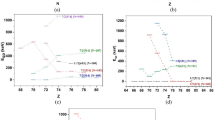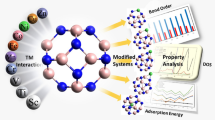Abstract
Among the family of lanthanide halides compounds, this work is devoted to the third halogen bromine. The presented lanthanum bromide LaBr molecule has a remarkable scientific interest regarding the other molecules because it presents few experimental studies and only one theoretical study. The theoretical electronic structure of the LaBr molecule is achieved by using the post-Hartree–Fock methods manifested by the complete active space self consistent field (CAS-SCF) method and the multi reference configuration interaction with single and double excitation (MRCI-SD) method. All of these calculations are performed via the quantum chemistry software MOLPRO. We predicted for the first time in the literature, 24 lowest-lying electronic states in the representation 2S+ 1Λ(±) and their corresponding components in the representation Ω(±) when taking into account the spin-orbit coupling (SOC), situated below 22,000 cm− 1. We calculated the spectroscopic constants for both cases (without/with SOC effects) related to the 13 singlet and 11 triplet states and for their components. We drew also in this paper the potential energy curves (PECs in a range of internuclear distance R varying from 2.00 to 4.22 Å.

Potential energy curves for 13 singlet electronic states of LaBr



Similar content being viewed by others
References
Rubinoff Daryl S, Evans Corey J, Gerry Michael CL (2003) The pure rotational spectra of the lanthanum monohalides, LaF, LaCl, LaBr, LaI. J Mol Spectrosc 218:169–179
Barrow RF, Bastin MW, Moore DLG (1967) Electronic states of states of gaseous fluorides of scandium, yttrium and lanthanum. Nature 215:1072–1073
Schall H, Linton C, Field RW (1983) Laser spectroscopy of LaF: determination of the separation of the singlet and triplet state manifolds. J Mol Spectrosc 100:437–448
Hildenbrand DL, Lau KH (1995) Thermochemical properties of the gaseous scandium, yttrium and lanthanum fluoride. J Chem Phys 102:3769–3775
Kaledin LA, Kaledin AL, Heaven MC (1997) Laser absorption spectroscopy of LaF: analysis of B 1π − X 1Σ+ transition. J Mol Spectrosc 182:50–57
Bernard A, Effantin C, d’Incan J, Verg’es J (2000) The (1)1π, (2)1Σ+ − X 1Σ+ transition of LaF. J Mol Spectrosc 202:163–165
Xin J, Klynning L (1994) Fourier transform spectroscopy of LaCl: rotational analyses of the infrared bands systems. Phys Scripta 49:209–213
Cao X, Dolg M (2005) Pseudopotential studies on the electronic structure of lanthanum monohalides LaF, LaCl, LaBr and LaI. J Theor Comput Chem 4:583–592
Fahs H, Allouche AR, Korek M, Aubert Frecon M (2002) Theoretical electronic structure of the lowest-lying states of the LaF molecule. J Chem Phys 117(8):3715–3720
Taher-Mansour F, Allouche AR, Aubert-Frecon M (2003) Theoretical electronic structure of the lowest-lying states of the LaI molecule. J Mol Spectrosc 221:1–6
Fahs H, Korek M, Allouche AR, Aubert-Frecon M (2004) Theoretical electronic structure of the lowest-lying states of the LaCl molecule. J Chem Phys 299:97–103
Hamade Y, El Sobbahi A (2018) Theoretical study of the electronic structure of mono-chloride of lanthanum molecule including spin-orbit coupling effect. J Mol Model 24:100–113
Hamade Y, Taher F, Choueib M, Monteil Y (2009) Theoretical electronic investigation of the low-lying electronic states of LuF molecule. Can J Phys 87:1163–1169
Hamade Y, Bazzi H, Sidawi J, Taher F, Monteil Y (2012) Ab initio study of the lowest-lying electronic states of LuCl molecule. J Phys Chem A 116:12123–12128
Davidson ER, Silver DW (1977) Size consistency in the dilute helium gas electronic structure. Chem Phys Lett 52(3):403–406
Martin WC, Zalubas R, Hagan L (1978) Nat Stand Ref Data Ser, NSRDS-NBS60,422 pp Nat Bur Stand
Stevens WJ, Krauss M, Basch H, Jasien PG (1992) . Can J Chem 70:612–630
Cao X, Dolg M (2001) Valence basis sets for relativistic energy-consistent small-core lanthanide pseudopotentials. J Chem Phys 115:7348–7355
Martin JML, Sundermann A (2001) Correlation consistent valence basis sets for use with the Stuttgart-Dresden-Bonn relativistic effective core potentials: The atoms Ga-Kr and In-Xe. J Chem Phys 114:3408–3420
Peterson KA, Figgen D, Goll E, Stoll H, Dolg M (2003) Systematically convergent basis sets with relativistic pseudopotentials. II. Small-core pseudopotentials and correlation consistent basis sets for the post-d group 16-18 elements. J Chem Phys 119:11099–11113
MOLPRO, a package of ab initio programs, H. -J. Werner, P. J. Knowles, G. Knizia, F. R. Manby, M. Schütz, and others, see http://www.molpro.net
Blondel C, Cacciani P, Delsart C, Trainham R (1989) High-resolution determination of the electron affinity of fluorine and bromine using crossed ion and laser beams. Phys Rev A 40:3698–3701
Author information
Authors and Affiliations
Corresponding author
Additional information
Publisher’s note
Springer Nature remains neutral with regard to jurisdictional claims in published maps and institutional affiliations.
Rights and permissions
About this article
Cite this article
Hamade, Y., Taher, F., Haidar, Y. et al. Theoretical study of the electronic structure of mono-bromide of lanthanum molecule including spin-orbit coupling effects. J Mol Model 25, 250 (2019). https://doi.org/10.1007/s00894-019-4114-4
Received:
Accepted:
Published:
DOI: https://doi.org/10.1007/s00894-019-4114-4




